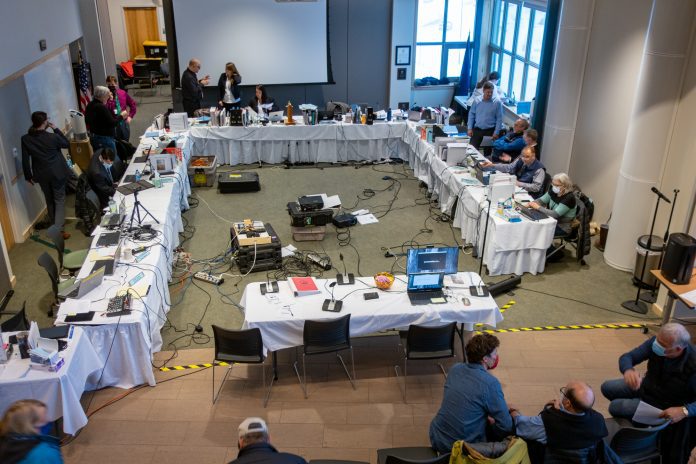
CDFU: Healthy salmon runs are testament to sound management by the state, hatchery operators
A proposal to lower hatchery production to its 2000 level went down in defeat at the Alaska Board of Fisheries meeting on Monday, March 4 in a 1-6 vote, after the majority of the board concluded that hatchery raised salmon were not causing undue harm to wild stocks.
The decision came after extensive testimony, mostly from fishing industry activists opposed to Proposal 43, which was offered by the Fairbanks Advisory Committee to the Board of Fisheries.
The board also took testimony at its Lower Cook Inlet meeting in Homer Nov. 26 through Dec. 1, but postponed any action until its Upper Cook Inlet meeting, from Feb. 23 through March 5 in Anchorage.
Stan Zuray, of Tanana, the only board member to vote for the proposal, said the effects of the state producing commercial opportunity for hatchery fisheries has made for great opportunity for commercial fisheries, while at the same time destroying significant subsistence and commercial economy and opportunities for village communities and processors in places like the Yukon River drainage. What is needed, said Zuray, is an open, continuing, independent review of research into the impact of hatchery salmon on wild stocks.
“Since my first hatchery meeting here in Anchorage in 2000, there has been a systematic unwillingness to do that,” he said.
Zuray has served for many years as chair of his local ADF&G advisory committee and as secretary of the Yukon River Drainage Fisheries Association.
Tom Carpenter of Cordova was one of several board members calling for a functional change in the way these hatchery proposals are brought before the board.
“We need to come up with a better way to handle that,” said Carpenter, co-chair of the Copper River Prince William Sound Advisory committee and a veteran commercial harvester. He noted that the Cook Inlet Aquaculture Association said if the cutback in hatchery production requested in Proposal 43 had been approved that it would have basically rendered that association incapacitated.
Board member Marit Carlson Van Dort of Anchorage, also a veteran commercial harvester, also commented that the issue of hatchery impact on wild salmon, as continuously proposed to the board was a process problem.
“Is it the hatchery’s responsibility to show it is not a problem or the other side to prove it is?” she asked.
And board member John Wood, of Willow, said his preference was not to see such a proposal again.
“This is like a zombie proposal that keeps coming up,” he said.
Fish and Game Commissioner Doug Vincent-Lang told the board he felt that the science regarding the impact of hatcheries on wild stocks is not conclusive and more study was needed, and if future research showed evidence of adverse impact of hatchery fish on wild salmon that he would not hesitate to use his authority to reduce the number of eggs used in production at the state hatcheries.
Cordova District Fishermen United (CDFU) applauded the board’s decision.
“Local wild salmon stocks were depressed before Prince William Sound hatcheries opened to produce fish that supported our wild runs rebuilding,” CDFU said in a statement issued on Monday. “Since hatcheries began operating in the 1970s both Prince William Sound and the Copper River have had numerous record-setting runs of both wild and hatchery-bound salmon. These historic runs of healthy salmon are a testament to sound management by both the state of Alaska and hatchery operators.”
Retired salmon biologist Steve Reifenstuhl, who spent 40 years working for the Northern Southeast Regional Aquaculture Association, was among a number of people who turned out at the meeting because of hatchery issues.
“This board made a good decision on proposal 43,” he said.
Reifenstuhl cited a report from the North Pacific Anadromous Fish Commission (NPAFC) in Vancouver, Canada, which conducted its International Year of the Salmon (IYS) Initiative from 2018-2022 and found no negative effect on survival of wild salmon due to hatchery fish. NPAFC members include Canada, the United States, Japan, the Russian Federation, and Republic of Korea, who collectively release millions of hatchery salmon into the ocean annually. He acknowledged conflicts between that report and a newly published report by Peter Rand, a research ecologist with the Prince William Sound Science Center, and Greg Ruggerone, a salmon scientist and vice president of Natural Resources Consultants in Seattle.
The Rand-Ruggerone report, published in February in the online ICES Journal of Marine Science, states that in response to ocean heating and hatchery production, pink salmon returning from the North Pacific Ocean steadily increased after 1975, leading to concerns about their influence on food webs and competition with other species.
Their study examined growth of this population during their two or three years at sea from 1977 to 2015 for eight populations in Alaska. They found that peak pink salmon abundances reduced growth of sockeye salmon from 7% to 14% during the second year in the ocean compared with growth when pink salmon abundance was low, while third-year growth was reduced to 17%. The overall effect of pink salmon abundance on sockeye growth was more than two times greater than the effect of sockeye salmon abundance, their report said.
Rand and Ruggerone also concluded that “production hatcheries and ocean heating contribute to the competitive dominance of pun salmon, underscoring the need to consider this unintended anthropogenic effect on the growth and productivity of sockeye salmon throughout the North Pacific.”














